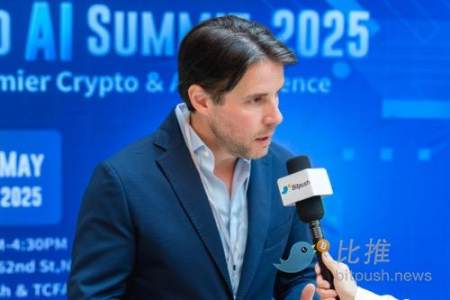At the CryptoAI Summit 2025 hosted by Bitpush, we exclusively interviewed John D'Agostino, Strategic Director of Coinbase Institutional. As a key participant in the institutionalization of crypto, John shared his insights into Bitcoin's evolving role, institutional crypto adoption, decentralized finance, and stablecoins.
Guest Introduction
John D Agostino is the Strategic Director of Coinbase Institutional, serving on the boards of several large hedge funds, venture capital funds, public companies, and the Alternative Investment Management Association (AIMA).
In 2019, John co-founded the AIMA Digital Assets Working Group. In 2021, he was appointed by the British Consulate in New York as Chair of the UK Royal Asset Management Working Group. In 2022, John was appointed as a Financial Innovation Researcher for the AIF Global Pension Network, and in 2024, he was appointed as a researcher at the MIT Computer Science and Artificial Intelligence Laboratory (CSAIL).
As a former Strategic Director of the New York Mercantile Exchange, John led the work of establishing the first Middle Eastern energy derivatives exchange in collaboration with the Dubai government, making him a protagonist in two New York Times bestsellers ('Rigged' and 'Start Up Of You').

'Bitcoin Has Decoupled from Broader Tech Stocks'
The day before the summit, BTC returned to $100,000 after months, sparking discussions about the return of a 'bull market'.
When asked about his view on this market sentiment, John D Agostino said: "BTC has reached $100,000 before, and these numbers are psychologically very, very important. They draw more public attention to such assets. I remember the first time oil broke $100 per barrel, it was a significant moment. However, we shouldn't overemphasize a specific number. I think what's more interesting is that as this price trend occurs, Bitcoin has decoupled from broader tech stocks."
John told Bitpush: "Suppose Bitcoin was at $90,000 instead of $100,000, but it had already decoupled this way in April and early May, as an investor, I would still be happy - if I bought it to improve my portfolio's Sharpe ratio and upside capture rate (which we call the Sortino ratio). Both in terms of its economic relationship with other assets and absolute performance, Bitcoin is performing exactly as people expected."
Institutional Whales: A Decade of 'Quiet Accumulation'
Since the approval of the spot Bitcoin ETF, more and more institutional investors have been positioning themselves in Bitcoin. According to SoSoValue data, as of May 15, the total inflow of US spot Bitcoin ETFs reached $343.47 million, continuing the five-week inflow trend since mid-April.
John D Agostino told Bitpush: "Even during periods when Bitcoin was declining and people weren't paying much attention, we never stopped seeing institutional interest grow. When we talk about institutions, many people think of hedge funds and asset management companies. These entities' responsibility is to find new ways to make money and new sources of alpha. They are obligated to pay attention to new asset classes that might generate alpha. So for ten years, their interest has been quietly growing, never stopping. Essentially, this growth has been slow and steady."
John explained: "They really like assets with low correlation to other asset classes, they like volatility - which might scare away some retail investors, but institutions like this volatility. They like assets that provide protection during downturns, have enough volatility for trading, and can also profit when broader assets are rising. So Bitcoin possesses all these characteristics."
"Currently, because institutions often have larger and more frequent trading volumes, and have more reporting requirements compared to ordinary retail users... they need an institutionalized market, a compliant market. We now have such a market. Coinbase has been operating in a compliant manner for ten years. But recently in the United States, the way government and regulatory agencies treat these assets has changed, making institutions more confident in trading on compliant platforms without worrying about any regulatory troubles in the United States. This is a relatively new change. So I naturally think we see more institutional interest, but this interest has never stopped."
Governments and Sovereign Wealth Funds Are About to Join the Wave
As previously reported by Bitpush, New Hampshire became the first state to pass a "Strategic Bitcoin Reserve" bill, and John also mentioned the growing participation of government agencies. He said: "Many states, countries, and sovereign wealth funds are already investing, even if they haven't publicly announced it."
He told Bitpush: "Frankly, I think the only thing hindering this process is leadership changes. As new leaders are elected - those who are more open, more willing to understand technology, more willing to learn about this innovation... as long as they spend time listening to voters' opinions and understanding this technology, our future direction will be quite clear. You will see more and more states, countries, and government-backed entities (such as sovereign wealth funds) not only researching it and buying it, but also willing to acknowledge that they indeed hold such assets. It's just a matter of time."
DeFi and Stablecoins: "Perfect Partners"
John is very optimistic about the development of DeFi and stablecoins, and believes that the rapid expansion of DeFi cannot be separated from the support of stablecoins.
He said: "I think centralized exchanges (CEX) and decentralized exchanges (DEX) will continue to increase, but there's no doubt that now is a good time for decentralized finance (DeFi), and it's an exciting moment for stablecoins. These two complement each other. DeFi needs a stable, scalable transaction layer - and stablecoins perfectly meet this need. Stablecoins are like lubricants for DeFi applications, enabling rapid expansion of various applications from derivatives to cross-border payments."
John believes that in the next 1-3 years, DeFi applications based on stablecoins - especially in cross-border payments and derivatives - will grow exponentially. He told Bitpush: "Although predictions of 'trillions of dollars in stablecoin transactions' might be somewhat aggressive, there's no doubt that the market size will far exceed the current one."
"Not Concerned with Short-Term Prices, Bitcoin's Portfolio Optimization Effect Remains Significant"
When asked about his view on Bitcoin's future trend, John stated that the core function of exchanges is not to predict the market, but to provide a reliable price discovery mechanism. He mentioned that psychological impacts of round numbers (such as $90,000 or $100,000) exist, but more worth noting is the changing correlation between Bitcoin and traditional assets, especially tech stocks. "If Bitcoin can maintain low correlation, even if the price temporarily stays at a certain point, its optimization effect on the portfolio remains significant."
John's sharing makes investors more convinced: The crypto market is transitioning from retail-dominated to institutionalized. As the compliance framework becomes more perfect, as sovereign funds quietly layout their strategies, and as DeFi infrastructure continues to evolve, we may be standing at the threshold of a new industry transformation.








